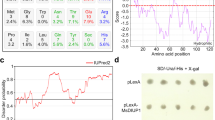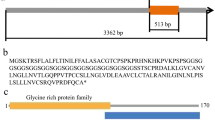Abstract
Key message
We cloned a novel salt stress-induced glycine-rich protein gene ( MsGRP ) from alfalfa. Its overexpression retards seed germination and seedling growth of transgenic Arabidopsis after salt and ABA treatments.
Abstract
Since soil salinity is one of the most significant abiotic stresses, salt tolerance is required to overcome salinity-induced reductions in crop productivity. Many glycine-rich proteins (GRPs) have been implicated in plant responses to environmental stresses, but the function and importance of some GRPs in stress responses remain largely unknown. Here, we report on a novel salt stress-induced GRP gene (MsGRP) that we isolated from alfalfa. Compared with some glycine-rich RNA-binding proteins, MsGRP contains no RNA recognition motifs and localizes in the cell membrane or cell wall according to the subcellular localization result. MsGRP mRNA is induced by salt, abscisic acid (ABA), and drought stresses in alfalfa seedlings, and its overexpression driven by a constitutive cauliflower mosaic virus-35S promoter in Arabidopsis plants confers salinity and ABA sensitivity compared with WT plants. MsGRP retards seed germination and seedling growth of transgenic Arabidopsis plants after salt and ABA treatments, which implies that MsGRP may affect germination and growth through an ABA-dependent regulation pathway. These results provide indirect evidence that MsGRP plays important roles in seed germination and seedling growth of alfalfa under some abiotic stress conditions.









Similar content being viewed by others
References
Bechtold N, Pelletier G (1998) In planta Agrobacterium-mediated transformation of adult Arabidopsis thaliana plants by vacuum infiltration. Methods Mol Biol 82:259–266
Bergeron D, Boivin R, Baszczynski CL, Bellemare G (1994) Root-specific expression of a glycine-rich protein gene in Brassica napus. Plant Sci 96:87–98
Burd CG, Dreyfuss G (1994) Conserved structures and diversity of functions of RNA-binding proteins. Science 265:615–621
Carpenter CD, Kreps JA, Simon AE (1994) Genes encoding glycine-rich Arabidopsis thaliana proteins with RNA-binding motifs are influenced by cold treatment and an endogenous circadian rhythm. Plant Physiol 104:1015–1025
Chang SJ, Puryear JD, Dias MADL, Funkhouser EA, Newton RJ, Cairney J (1996) Gene expression under water deficit in loblolly pine (Pinus taeda): isolation and characterization of cDNA clones. Physiol Plant 97:139–148
Condit CM (1993) Developmental expression and localization of petunia glycine-rich protein 1. Plant Cell 5:277–288
de Oliveira DE, Seurinck J, Inzé D, Van Montagu M, Botterman J (1990) Differential expression of five Arabidopsis genes encoding glycine-rich proteins. Plant Cell 2:427–436
Dunn MA, Brown K, Lightowlers R, Hughes MA (1996) A low-temperature-responsive gene from barley encodes a protein with single-stranded nucleic acid-binding activity which is phosphorylated in vitro. Plant Mol Biol 30:947–959
Duzan HM, Zhou X, Souleimanov A, Smith DL (2004) Perception of Bradyrhizobium japonicum Nod factor by soybean [Glycine max (L.) Merr.] root hairs under abiotic stress conditions. J Exp Bot 55:2641–2646
Ferullo JM, Vezina LP, Rail J, Laberge S, Nadeau P, Castonguay Y (1997) Differential accumulation of two glycine-rich proteins during cold-acclimation alfalfa. Plant Mol Biol 33:625–633
Golldack D, Luking I, Yang O (2011) Plant tolerance to drought and salinity: stress regulating transcription factors and their functional significance in the cellular transcriptional network. Plant Cell Rep 30:1383–1391
Gomez J, Sanchez-Martinez D, Stiefel V, Rigau J, Puigdomenech P, Pages M (1988) A gene induced by the plant hormone abscisic acid in response to water stress encodes a glycine-rich protein. Nature 334:262–264
Jefferson RA, Kavanagh TA, Bevan MW (1987) GUS fusions: beta-glucuronidase as a sensitive and versatile gene fusion marker in higher plants. EMBO J 6:3901–3907
** H, Sun Y, Yang Q, Chao Y, Kang J, Li Y, Margaret G (2010) Screening of genes induced by salt stress from Alfalfa. Mol Biol Rep 37:745–753
Keller B, Sauer N, Lamb C (1988) Glycine-rich cell wall proteins in bean: gene structure and association of the protein with the vascular system. EMBO J 7:3625
Kim JS, Jung HJ, Lee HJ, Kim KA, Goh CH, Woo YM, Oh SH, Han YS, Kang H (2008) Glycine-rich RNA-binding protein7 affects abiotic stress responses by regulating stomata opening and closing in Arabidopsis thaliana. Plant J 55:455–466
Laberge S, Castonguay Y, Vézina LP (1993) New cold- and drought-regulated gene from Medicago sativa. Plant Physiol 101:1411
Lei M, Wu R (1991) A novel glycine-rich cell wall protein gene in rice. Plant Mol Biol 16:187–198
Lichtenthaler HK (1987) Chlorophylls and carotenoids: pigments of photosynthetic biomembranes. Methods Enzymol 148:350–382
Molina A, Mena M, Carbonero P, Garcia-Olmedo F (1997) Differential expression of pathogen-responsive genes encoding two types of glycine-rich proteins in barley. Plant Mol Biol 33:803–810
Munns R, Tester M (2008) Mechanisms of salinity tolerance. Annu Rev Plant Biol 59:651–681
No EG, Flagler RB, Swize MA, Cairney J, Newton RJ (1997) cDNAs induced by ozone from Atriplex canescens (saltbush) and their response to sulfur dioxide and water-deficit. Physiol Plant 100:137–146
Ringli C, Keller B, Ryser U (2001) Glycine-rich proteins as structural components of plant cell walls. Cell Mol Life Sci 58:1430–1441
Sachetto-Martins G, Franco LO, de Oliveira DE (2000) Plant glycine-rich proteins: a family or just proteins with a common motif? Biochim Biophys Acta 1492:1–14
Showalter AM, Butt AD, Kim S (1992) Molecular details of tomato extensin and glycine-rich protein gene expression. Plant Mol Biol 19:205–215
van Nocker S, Vierstra RD (1993) Two cDNAs from Arabidopsis thaliana encode putative RNA binding proteins containing glycine-rich domains. Plant Mol Biol 21:695–699
Ye ZH, Song YR, Marcus A, Varner JE (1991) Comparative localization of three classes of cell wall proteins. Plant J 1:175–183
Zahran HH (1999) Rhizobium-legume symbiosis and nitrogen fixation under severe conditions and in an arid climate. Microbiol Mol Biol Rev 63:968–989, table of contents
Zhu JK (2002) Salt and drought stress signal transduction in plants. Annu Rev Plant Biol 53:247–273
Acknowledgments
This work was supported by the National Natural Science Foundation of China (No. 30970409).
Author information
Authors and Affiliations
Corresponding author
Additional information
Communicated by E. Benvenuto.
Rights and permissions
About this article
Cite this article
Long, R., Yang, Q., Kang, J. et al. Overexpression of a novel salt stress-induced glycine-rich protein gene from alfalfa causes salt and ABA sensitivity in Arabidopsis. Plant Cell Rep 32, 1289–1298 (2013). https://doi.org/10.1007/s00299-013-1443-0
Received:
Revised:
Accepted:
Published:
Issue Date:
DOI: https://doi.org/10.1007/s00299-013-1443-0




